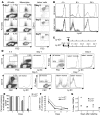Monocyte subsets differentially employ CCR2, CCR5, and CX3CR1 to accumulate within atherosclerotic plaques
- PMID: 17200718
- PMCID: PMC1716202
- DOI: 10.1172/JCI28549
Monocyte subsets differentially employ CCR2, CCR5, and CX3CR1 to accumulate within atherosclerotic plaques
Abstract
Monocytes participate critically in atherosclerosis. There are 2 major subsets expressing different chemokine receptor patterns: CCR2(+)CX3CR1(+)Ly-6C(hi) and CCR2(-)CX3CR1(++)Ly-6C(lo) monocytes. Both C-C motif chemokine receptor 2 (CCR2) and C-X(3)-C motif chemokine receptor 1 (CX3CR1) are linked to progression of atherosclerotic plaques. Here, we analyzed mouse monocyte subsets in apoE-deficient mice and traced their differentiation and chemokine receptor usage as they accumulated within atherosclerotic plaques. Blood monocyte counts were elevated in apoE(-/-) mice and skewed toward an increased frequency of CCR2(+)Ly-6C(hi) monocytes in apoE(-/-) mice fed a high-fat diet. CCR2(+)Ly-6C(hi) monocytes efficiently accumulated in plaques, whereas CCR2(-)Ly-6C(lo) monocytes entered less frequently but were more prone to developing into plaque cells expressing the dendritic cell-associated marker CD11c, indicating that phagocyte heterogeneity in plaques is linked to distinct types of entering monocytes. CCR2(-) monocytes did not rely on CX3CR1 to enter plaques. Instead, they were partially dependent upon CCR5, which they selectively upregulated in apoE(-/-) mice. By comparison, CCR2(+)Ly-6C(hi) monocytes unexpectedly required CX3CR1 in addition to CCR2 and CCR5 to accumulate within plaques. In many other inflammatory settings, these monocytes utilize CCR2, but not CX3CR1, for trafficking. Thus, antagonizing CX3CR1 may be effective therapeutically in ameliorating CCR2(+) monocyte recruitment to plaques without impairing their CCR2-dependent responses to inflammation overall.
Figures







Comment in
-
Macrophage heterogeneity and tissue lipids.J Clin Invest. 2007 Jan;117(1):89-93. doi: 10.1172/JCI30992. J Clin Invest. 2007. PMID: 17200712 Free PMC article.
References
-
- Gu L., et al. Absence of monocyte chemoattractant protein-1 reduces atherosclerosis in low density lipoprotein receptor-deficient mice. Mol. Cell. 1998;2:275–281. - PubMed
-
- Boring L., Gosling J., Cleary M., Charo I.F. Decreased lesion formation in CCR2–/– mice reveals a role for chemokines in the initiation of atherosclerosis. Nature. 1998;394:894–897. - PubMed
-
- Kuziel W.A., et al. CCR5 deficiency is not protective in the early stages of atherogenesis in apoE knockout mice. Atherosclerosis. 2003;167:25–32. - PubMed
-
- Zernecke A., et al. Deficiency in CCR5 but not CCR1 protects against neointima formation in atherosclerosis-prone mice: involvement of IL-10. Blood. 2006;107:4240–4243. - PubMed
Publication types
MeSH terms
Substances
Grants and funding
LinkOut - more resources
Full Text Sources
Other Literature Sources
Medical
Molecular Biology Databases
Research Materials
Miscellaneous

